Our Welcoming Reception & 1st Waiting Area
Our Ground Floor Operatory
Our Ground Floor Operatory
Our Laboratory
Our Display Area With Updated Oral Hygiene Measures
Our First Floor Operatory
Our First Floor Operatory
Dentures and Bridge
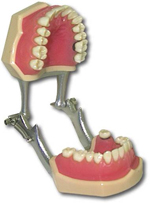
Few people want to have their teeth extracted just to look better. But when restoring the teeth is impossible because there is simply not enough tooth structure left, dentures are an alternative.
It is important from a cosmetic standpoint, however, that you need not allow too much time to lag between tooth loss and tooth replacement. Tooth loss causes the face to collapse and the mouth to sink in. At the same time, the nose appears to drop down towards the chin. Deep lines begin to from in the creases of this collapses skin, adding years to the face.
 Full dentures can make you look younger because there is almost no limit to what the dentist can create with them.these job is done by your prosthodontist.
Full dentures can make you look younger because there is almost no limit to what the dentist can create with them.these job is done by your prosthodontist.
A prosthodontist is a dentist who specializes in prosthodontics. Prosthodontists specialize in the restoration of oral function by creating prostheses and restorations (i.e. Complete dentures, crowns, implant retained/supported restorations).
Prosthodontic training requires an additional 3years of training after obtaining a dental degree (B.D.S). And we are having highly skilled Dr. Rakshith Hegde to treat you best.
FREQUENTLY ASKED QUESTION
- Q: What are Dentures?
- Q: What are Immediate dentures?
- Q: What are advantages of immediate dentures?
- Q: What are Removable Partial Denture?
- Q: How are dentures made?
- Q: What steps are involved in getting a conventional denture?
- Q: What are fixed dentures?
- Q: Why does my denture need to be relined?
- Q: How often should I have my denture checked?
- Q: What is the difference between a denture and a crown or bridge?
- Q: What is a dental bridge?
- Q: How is a dental bridge constructed?
- Q: Who is a candidate for bridges?
- Q: What are the different types of dental bridges?
- Q: What is the procedure for bridge?
- Q: What are the advantages and disadvantages of bridge?
- Q: How can I take care of my mouth after having bridge?
- Q: What is better, a bridge or an implant?
Still have questions?
Ask us for more information.
Q: What are Dentures?
A: A denture is an appliance that replaces teeth. It may be replacing all the teeth (full denture) which can further be conventional (You remove it to clean it) and implant supported (fixed dentures) or some of them (partial denture replacing few missing teeth).
Q: What are Immediate Dentures?

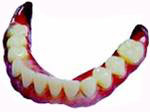 A: Immediate dentures are measured for size with the natural teeth intact, and they are placed the same day as your remaining teeth are extracted. After extraction of teeth, shrinkage of bone takes place for the first 4-5 months and hence a temporary denture is given to the patient. This is called as immediate denture. This denture should be used for 4 to 6 months and should be replaced.
A: Immediate dentures are measured for size with the natural teeth intact, and they are placed the same day as your remaining teeth are extracted. After extraction of teeth, shrinkage of bone takes place for the first 4-5 months and hence a temporary denture is given to the patient. This is called as immediate denture. This denture should be used for 4 to 6 months and should be replaced.
Q: What are advantages of immediate dentures?
A: There are following advantages of immediate dentures:
- Patient can enjoy his social life i.e. if he waits for 6 months after total extraction of teeth, he has to move around without teeth.
- Patient can chew better i.e. as the wound healing has not taken place, he cannot chew hard food but this denture helps him to eat better.
- From medical point of view, this denture helps to stabilize his lower jaw i.e. if the patient stays without teeth for six months, his lower jaw drifts forward.
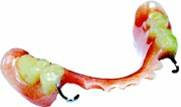

Q: What are Removable Partial Denture?
A: Removable Partial Denture (RPD) is least used. It is an easy and cheap replacement of missing tooth.
It is of two type :
- Crylic
- Cast Partial (Metal base)
Q: How are dentures made?
A: Many removable dentures rely on some of your remaining natural teeth to help keep them in. Your natural teeth were never designed to help support a denture. In most cases, some minor modification of your natural teeth would be desirable to improve the wearability and life of your denture. Your dentist has the required training to be able to modify your teeth to ensure the highest quality removable denture is constructed around your natural teeth.
Q: What steps are involved in getting a conventional denture?
A: Before any denture treatment is undertaken, it is recommended that you have a thorough dental check-up. If you are having full dentures, it will involve an examination of the mouth and an assessment of the health of the gums.
If you are having a partial denture, this check-up will include a full examination of your teeth, gums and other soft tissues of your mouth. At this check-up radiographs may be taken to ensure the teeth are healthy, and strong enough to help support a denture. Remember, the only oral practitioner who has the training and is legally able to undertake such a thorough check-up is your local dentist. When gums and bones heal properly, removable complete denture is prepared. There are 5 sittings.
1. First Sitting - Primary Impression :
This sitting takes only 10 minutes. Impression of gums and jaws is made with the help of trays. The trays used to make the impression are of standard prefabricated sizes.
2. Second Sitting - Final Impressions :
This is a very important step. It decides the fit of a denture. The tray used to make this impression is specially fabricated for every individual.
This consists of two stages :
- Border Molding
- Zinc-Eugenol Paste Impression
3. Third Sitting - Jaw Relation :
It decides position, size, shape of teeth and hence, is a significant step in denture making. With the help of wax a relation between upper and lower jaw is noted. This relation is sent to the laboratory.
4. Fourth Sitting - Trial :
With the help of the relation of jaws taken previously, a denture in wax is made where all the teeth are placed in wax. This trial denture is placed in the patients mouth. This enables the patient to note the size, shape, color, occlusion and overall appearance of his teeth. Any changes regarding his teeth can be fixed at this stage, hence is a decisive stage.
5. Fifth Sitting - Denture Delivery :
A polished, finished denture is delivered to the patient. Instructions of how to use a denture are given to the patient.
6. Follow - Ups :
A new denture may hurt, like a shoe-bite and hence may require little adjustments.
The different qualities of dentures are :
- Acrylic denture
- Lucitone denture
- Fiber glass denture
- Cast (metal base) denture
Q: What are fixed dentures?
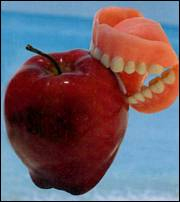
A: The fixed dentures are fixed in your oral cavity and generally known as implant supported dentures. They are bit costlier than conventional dentures. Generally the patient wants fixed dentures due to the following reasons:
- Individuals who are unhappy with their present denture.
- Those who would like to eat with more comfort.
- People who want a secure feeling when talking, laughing and smiling.
Q: What are fixed dentures?
A: The fixed dentures are fixed in your oral cavity and generally known as implant supported dentures. They are bit costlier than conventional dentures. Generally the patient wants fixed dentures due to the following reasons:
- Individuals who are unhappy with their present denture.
- Those who would like to eat with more comfort.
- People who want a secure feeling when talking, laughing and smiling.
Q: Why does my denture need to be relined?
A: The rapid shrinkage of bone following extractions means the denture will soon need to have the fitting surface relined once that shrinkage has slowed down enough. After a reline, patients report a much better fit. This relining maybe done between three and six months after an immediate denture has been fitted. Your dentist will advise you when an immediate denture is ready to be relined.
Relining involves an additional fee, but this is going to be cheaper than a new set of dentures and it is often very much appreciated.
All dentures lose their fit through natural changes in your mouth. Chewing gum, biting your nails or grinding your teeth can accelerate this. You should see your dentist yearly for a denture check, when refitting or relining may be necessary. For example, many patients report that their full dentures are loose after a period of rapid weight loss.
Q: How often should I have my denture checked?
A: If you currently wear removable dentures of any kind, it is advisable that you have these checked regularly. It is recommended if you have any remaining natural teeth you should have these and your dentures reviewed every six months or as directed by your dentist. If you have no natural teeth and wear removable full dentures, your dentures should be reviewed at least every two years.
Q: What is the difference between a denture and a crown or bridge?
 A: Removable dentures are those dentures (plates) the wearer can remove and replace at will. These types of dentures can replace one tooth, all your natural teeth, or any number of missing teeth in between. A crown or a bridge is fixed or cemented in place and cannot be removed.
A: Removable dentures are those dentures (plates) the wearer can remove and replace at will. These types of dentures can replace one tooth, all your natural teeth, or any number of missing teeth in between. A crown or a bridge is fixed or cemented in place and cannot be removed.
Q: What is a dental bridge?
A: A dental bridge is an appliance used to replace one or more missing teeth. These appliances are cemented into place and cannot be removed by the patient.
Q: How is a dental bridge constructed?
A: As the name of this appliance implies, the bridge is made out of three pieces that fit into the open space in the mouth, "bridging" the gap. Most bridges are made of a pontic tooth (or false tooth), held together by two crowns (a "cap" that covers the tooth, approximating its normal size and shape). This trio is then attached (cemented) to the abutment teeth (the surrounding teeth of each side of the gap).
Q: Who is a candidate for bridges?
A: Nearly everyone who has one or more missing teeth is a candidate for a dental bridge. However, the difference between proper and improper oral hygiene is, generally, what determines the success of the dental bridge.
Q: What are the different types of dental bridges?
A: There are several different types of dental bridges. Your dentist or oral health specialist will recommend the most appropriate one for your mouth condition and the location of the missing tooth or teeth.
Traditional Bridge -a pontic tooth (or false tooth) is held together by two crowns (a "cap" that covers the tooth, approximating its normal size and shape). This trio is then attached (cemented) to the abutment teeth (the surrounding teeth of each side of the gap)
Resin bonded Bridge (also known as a "Maryland" Bridge) - this type of bridge involves the pontic (false) teeth being fused together to metal bands, bonded to the back of the abutment teeth with a resin cement. This type of procedure is common when the teeth missing are in the front of the mouth.
Cantilever Bridge - this type of procedure is most appropriate when there is only one abutment tooth on either side of the span.
Q: What is the procedure for bridge?
A: This is minor surgical procedure can be done under local anesthesia. Then your dentist will prepare the teeth surrounding the open space. If these teeth already have fillings, part of the filling may be left in place to provide a solid foundation for the crown.
An impression is made and from this model a dental lab will create the bridge, false tooth and crowns. You will wear a temporary bridge in the mean until you return for your second appointment. Your new bridge will be fitted and adjusted before being cemented to your teeth.
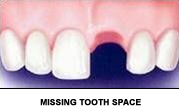
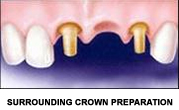
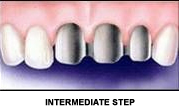
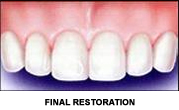
Q: What are the advantages and disadvantages of bridge?
A: Advantages :
- Dental bridges are natural in appearance.
- They usually require only two visits to your dentist.
- Dental bridges can reduce your risk of gum disease.
- They can help to correct some bite issues and even improve your speech.
- If you maintain good oral hygiene, your fixed bridge should last as many as ten years or more.
Disadvantages :
- For a few weeks after the treatment, your teeth will probably be sensitive to extreme temperatures.
- If sufficient oral hygiene is not practiced the bacteria on your teeth and gums could become infected.
- Cutting of your natural tooth.
Q: How can I take care of my mouth after having bridge?
A: The following precautions can help you to reduce oral health problems when you are having bridge.
- Brush your teeth carefully after every meal with fluoride toothpaste and a soft-bristled toothbrush, as food may become lodged causing the gums and teeth to become infected. This may lead to further complications resulting in the loss of the bridge.
- Floss daily, Your dentist, or other oral health specialist, may recommend using a floss threaded for hard-to-reach places between the bridge and its adjacent teeth.
- Have your teeth cleaned every 6 months by an oral health professional.
- Limit your sugar and starch intake, as debris left behind from these types of foods may turn into damaging acids, which, in addition to promoting plaque formation, may also be harmful to teeth and gums.
- Avoid hard and/or sticky snacks. This includes foods such as popcorn, hard or chew candy, caramel, and/or nuts.
Q: What is better, a bridge or an implant?
A: They each have advantages and disadvantages. We are not advocates of one treatment over another. Since any cosmetic situation that involves a missing tooth presents its own challenges and circumstances, careful and well thought out plans will give the best outcome. The advantage of an implant is that it will permanently replace a tooth since it’s anchored in the bone with a crown placed on top of it. A disadvantage of implants is that it can take at least 6-8 months to complete. Bridges are not anchored into the bone like implants are, but they are anchored to adjacent teeth. This will require preparation of teeth for crowns. If you have teeth that do not have any fillings in them or they are minimally restored you might not want to put crowns on them for a bridge. In this case it would be better to do an implant.
But, the advantage of having a bridge as opposed to an implant is that it is fairly quick and can be completed in a few short weeks. Bridges can be done with an all porcelain system so that they can look beautiful. If the adjacent teeth are getting weak from poor bone support or excessively large fillings, having a bridge in place will give the teeth more support. With the all porcelain systems, teeth can be prepared for bridges more conservatively than before. Another disadvantage of having a bridge is that the teeth that are anchoring the bridge can no longer be flossed. An implant supported crown is a separate unit and is flossed like your own teeth.
Click Here To See Photo Gallery : Dentures
